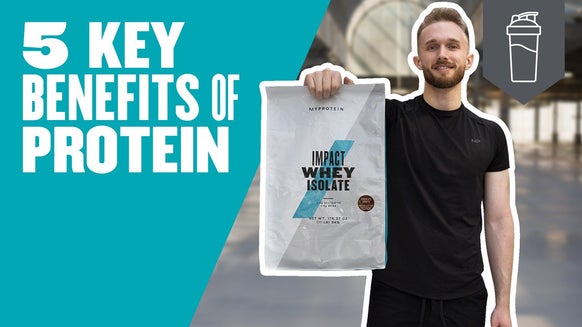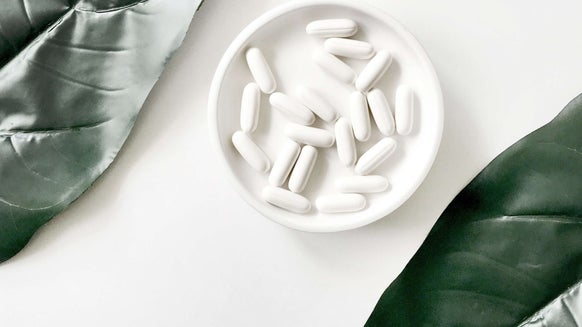
If you’ve heard anything about creatine, then you’ve probably heard about starting out with a creatine loading phase. But this leads to a tonne of other questions, like what exactly this means, how to load creatine, how much more to take and for how long. The list is endless. Before you get wrapped up in mountains of research, we’ve got the essentials right here.
For anyone looking to pack on muscle, sprint faster, recover better, or add some extra weight to their lifting, creatine is one of the most effective supplements available.
- Benefits of creatine
- Pros of creatine loading
- What does creatine do?
- What is creatine loading?
- When should you take creatine & is a loading phase necessary?
- Types of creatine supplements
Looking for info quick? Get to grips with the creatine loading phase in 5 mins with this video...
[su_youtube_advanced url="https://www.youtube.com/watch?v=IbLIyA6AlS4"]
Benefits of creatine
1. Increased muscle mass
When combined with resistance training, creatine supplementation has been repeatedly shown to be a very effective way to increase muscle mass.
One of the main reasons for this is that having full creatine storage can help you complete more reps and sets at the same weight. Over time this will lead to greater training adaptations and ultimately more muscle mass.
2. Athletic performance
For those looking to enhance upper body strength, creatine can be particularly beneficial. As well as increased muscle mass in the upper body area, creatine supplementation has been shown to significantly boost bench press performance, a key lift when looking to build upper body strength.
Any athletes competing in sports who require quick recovery from repeated sprints may find creatine supplementation especially helpful.
3. Recovery
Pros of creatine loading
1. Instant results
2. Sustainable
Following a loading phase, if you drop down to a maintenance dose, you’ll sustain the muscle mass and strength gains made. Your body typically uses 1-2% of your creatine stores on a daily basis, so a daily maintenance dose of 3g-5g will be enough to make sure your stores stay full and your performance in the gym stays high.1
3. Better pump
As well as all the extra reps and heavier sets, full creatine stores will help you to perform better as creatine has osmotic properties.14 This means it will draw water into the muscle cell, causing a swelling effect. This will lead to a better pump, with your muscles also looking fuller. This swelling effect could have other potential benefits too. It may also be the case that this will lead to the triggering of muscle protein synthesis, which is the process where your body builds muscle.15
What does creatine do?
In your body, creatine combines with the chemical compound phosphagen to form phosphocreatine (PCr), which is used for muscle contraction. During explosive exercise, such as a heavy set of squats or a 60m sprint, the body uses ATP, which is the body's main energy carrier.3
Your ability to perform at a high intensity is reliant on your muscles having a supply of ATP. PCr helps your body generate this vitally important ATP, enabling you to perform at the required intensity for longer.3
During explosive movements, such as weight training or sprinting, your body also uses PCr as fuel. By boosting your body’s available PCr stores, you can hit those all-important extra reps.3
This increased quality of work over a long period of time will lead to greater training adaptations such as increased muscle mass, greater strength, and faster sprint times.1
What is creatine loading?
Creatine loading means taking a larger amount of creatine than the maintenance dosage (3g) for several days, which will enable you to maximise your creatine storage as quickly as possible.2 This results in faster training gains and improved performance compared to what a normal dose for maintenance would give you.2
The process enables you to saturate your body’s creatine stores as quickly as possible. For those eating a typical diet containing meat and fish, creatine storage ranges between 60-80% full.
A typical loading strategy would be to consume 20g creatine a day (5g x4) for 5-7 days.2 This will be enough to ensure your muscle creatine stores are fully saturated and you’re ready to start making increased training gains.
When should you take creatine, and is a loading phase necessary?
A creatine loading phase isn’t strictly necessary.1 Evidence shows that supplementing with a smaller dose will have the same effect, but it’ll just take a bit longer to maximise creatine storage, which can be achieved by a daily dose of 3-5g.
So, to achieve the same benefits when taking creatine without loading, you’ll have to wait around 3 weeks longer. If you have a competition looming or are eager to start seeing muscle gains as quickly as possible, you could miss out on 3 vital weeks of training at your full potential that would otherwise be provided by optimised creatine storage.
Learn more about Creatine timing in this article below...
Types of creatine supplements
There are a number of different types of creatine on the market. Some of these include:
- Creatine monohydrate
- Creatine ethyl-ester
- Micronized creatine
- Creatine kre-alkalyn
Whilst all provide slightly different benefits, creatine monohydrate is the most heavily researched.1 There’s very little evidence to show any other form of creatine is more beneficial and, with it being the cheapest form, it may well be the best choice for most.
Creatine can come in powder or tablet form. Neither makes a difference when it comes to effectiveness, so this choice is down to personal preference.1 A powder can be mixed into a pre-workout shake, whereas tablets are easy to take when on the go.
Take home message
Creatine is a highly effective supplement for building muscle and increasing strength and power. It’ll also help you to recover and enable you to handle the high training volumes needed to make progress.
FAQ
How do I load creatine?
Is creatine loading safe?
How long should the creatine loading phase be?
Is creatine loading necessary?
How often should you load creatine?
READ THESE NEXT:

Liam is a certified sport nutritionist with the International Society of Sport Nutrition and is enrolled on the British Dietetics Association’s Sport and Exercise Nutrition register. He has a Bachelor’s of Science in Sport and Exercise Science and is graduate of the ISSN Diploma in Applied Sport and Exercise Nutrition.
Liam is an experienced personal trainer, helping clients reach their health and fitness goals with practical, evidence informed exercise and nutrition advice.
In his spare time Liam has competed in numerous powerlifting competitions and enjoys hill walking, football and expanding his recipe repertoire in the kitchen. Find out more about Liam's experience here.
- Buford TW, Kreider RB, Stout JR, Greenwood M, Campbell B, Spano M… Antonio J (2007). International Society of Sports Nutrition position stand: creatine supplementation and exercise. Journal of the International Society of Sports Nutrition. 4:6.
- Hultman, E., Soderlund, K., Timmons, J., Cederblad, G. and Greenhaff, P. (1996). Muscle creatine loading in men. Journal of Applied Physiology, 81(1), pp.232-237.
- Antonio, J., Kalman, D., Stout, J., Greenwood, M., Willoughby, D. and Haff, G. (2014). Essentials of sports nutrition and supplements. [NY]: Humana Press.
- Kreider RB, Kalman DS, Antonio J, Ziedenfuss TN, Wildman R, Collins R…. Lopez H. (2017). International Society of Sports Nutrition position stand: safety and efficacy of creatine supplementation in exercise, sport, and medicine. Journal of the International Society of Sports Nutrition. 14:18
- Nunes JP, Ribeiro AS, Schoenfeld BJ, Tomeleri CM, Avelar A, Trindade MC, Nabucco HC..Cyrino ES. (2017). Creatine supplementation elicits greater muscle hypertrophy in upper than lower limbs and trunk in resistance-trained men. Nutr Health. Dec;23(4):223-229
- Burke DG, Candow DG, Chilibeck PD, MacNeil LG, Roy BD, Tarnopolsky MA, Ziegenfuss T: Effect of creatine supplementation and resistance-exercise training on muscle insulin-like growth factor in young adults. Int J Sport Nutr Exerc Metab 2008, 18:389–398.
- Rawson ES, Volek JS. (2003). Effects of creatine supplementation and resistance training on muscle strength and weightlifting performance. J Strength Cond Res. Nov;17(4):822-31
- Mujika I, Padilla S, Ibanez J, Izquierdo M, Gorostiaga E. Creatine supplementation and sprint performance in soccer players. Med Sci Sports Exerc 2000;32:518-525.
- Vandenberghe M, Goris P, Van Hecke M Van Leemputte L, Hespel P. (1997). Long term creatine intake is beneficial to muscle performance during resistance training. J Appl Physiol. Dec;83(6):2055-63.
- MacDougall JD, Ray S, Sale DG, McCartney N, Lee P, Gamer S. (1999) Muscle substrate utilization and lactate production during weightlifting. Can J Appl Physiol 1999; 24(3):209-215.
- Santos, R., Bassit, R., Caperuto, E. and Costa Rosa, L. (2004). The effect of creatine supplementation upon inflammatory and muscle soreness markers after a 30km race.Life Sciences, 75(16), pp.1917-1924.
- Volek, J., Ratamess, N., Rubin, M., Gomez, A., French, D., McGuigan, M., Scheett, T., Sharman, M., Hokkinen, K. and Kraemer, W. (2004). The effects of creatine supplementation on muscular performance and body composition responses to short-term resistance training overreaching.European Journal of Applied Physiology, 91(5-6), pp.628-637.
- Volek JS, Kraemer WJ, Bush JA, Boetes M, Incledon T, Clark KL, Lynch JM: Creatine supplementation enhances muscular performance during high-intensity resistance exercise. J Am Diet Assoc 97: 765– 770, 1997
- Bird SP. (2003) Creatine supplementation and exercise performance: A brief review. J Sports Sci Med. 2(4): 123-132.
- Kreider RB. (2003. Effects of creatine supplementation on performance and training adaptations. Mol Cell Biochem. 2003;244(1–2):89–94.
Related Posts

5 Key Benefits of Protein | How Protein Can Help with Muscle Growth, Weight Loss, Aging & More







